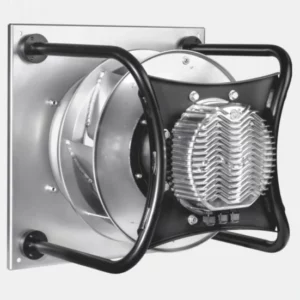Radial blade centrifugal fans, also known as radial fans or radial blowers, are used in various applications that require moderate airflow and high static pressure. These fans are characterized by their straight blades extending radially from the center of the fan.
Here are some common applications where radial blade centrifugal fans are used:
- Industrial Ventilation: Radial fans are employed in industrial ventilation systems to exhaust fumes, smoke, and airborne contaminants from manufacturing facilities, warehouses, and other industrial spaces. They are capable of handling high static pressure and can overcome resistance caused by long ductwork or filters.
- Dust Collection Systems: Radial fans are utilized in dust collection systems to extract and transport airborne particles and contaminants generated during industrial processes. These fans create the necessary suction to collect dust and transport it through the collection system.
- Material Handling: Radial fans are used in material handling applications, such as pneumatic conveying systems. They provide the necessary airflow to transport bulk materials, such as grains, powders, and granules, through pipes or ducts.
- Industrial Ovens and Dryers: Radial fans are employed in industrial ovens and dryers to circulate hot air and facilitate the drying or curing of products. These fans ensure uniform heat distribution, helping to achieve consistent and efficient drying processes.
- Combustion and Burner Systems: Radial fans are used in combustion systems and burner applications to provide the necessary air supply for efficient combustion. They ensure proper air-to-fuel ratios, aiding in complete combustion and improved energy efficiency.
- Air Pollution Control: Radial fans play a role in air pollution control systems, such as scrubbers and air scrubbing equipment. These fans assist in the removal of pollutants and particulate matter from industrial exhaust gases.
- HVAC Systems: While not as common as other fan types, radial fans can be used in certain HVAC applications where high static pressure is required, such as in ducted systems with significant resistance.
It’s important to note that the specific design and characteristics of a radial fan can vary based on the application requirements. Radial fans can be customized to match different airflow and pressure needs, making them suitable for a range of industrial and commercial applications.
How do radial blade centrifugal fans differ from other types of centrifugal fans?
Radial blade centrifugal fans, also known as radial fans or radial blowers, differ from other types of centrifugal fans primarily in their blade design and airflow characteristics.
Here are some key differences:
- Blade Design: Radial fans have straight blades that extend radially from the center of the fan. These blades are typically curved backward, allowing them to efficiently move air in a radial direction. In contrast, other types of centrifugal fans, such as forward curved and backward curved fans, have blades that are angled or curved differently.
- Airflow Direction: Radial fans generate airflow in a primarily radial direction, with the air being discharged perpendicular to the fan’s axis of rotation. This airflow pattern is suitable for applications that require high static pressure and moderate airflow. In contrast, other centrifugal fan types, like forward curved and backward curved fans, generate airflow that has more of a tangential or axial component.
- Pressure-Flow Characteristics: Radial fans are known for their ability to generate high static pressure, making them suitable for applications with high resistance to airflow, such as in ducted systems or systems with filters. They are capable of handling moderate airflow rates while maintaining high pressure levels. In comparison, forward curved fans are more suitable for low-pressure, high-flow applications, while backward curved fans strike a balance between pressure and flow.
- Efficiency: Radial fans typically have lower efficiency compared to forward curved and backward curved fans. This is because the straight blades of radial fans tend to generate more turbulence and airflow separation, leading to increased energy losses. However, they excel in high-pressure applications where efficiency may be traded for the ability to overcome resistance.
- Noise Generation: Radial fans generally produce more noise compared to forward curved and backward curved fans due to the air turbulence caused by the straight blade design. However, noise levels can be mitigated through proper fan design, housing insulation, and acoustic treatments.
It’s important to consider the specific requirements of the application when selecting the type of centrifugal fan. Radial blade centrifugal fans are preferred for applications that demand high static pressure, moderate airflow rates, and the ability to overcome resistance caused by ductwork, filters, or other obstructions.
